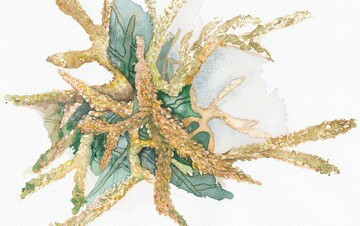The staghorn coral (Acropora cervicornis) is a branching, stony coral with cylindrical branches ranging from a few centimetres to over two metres in length and height. It occurs in back reef and fore reef environments from 0 to 30 metres (0 to 98 ft) depth. The upper limit is defined by wave forces, and the lower limit is controlled by suspended sediments and light availability. Fore reef zones at intermediate depths 5–25 metres (16–82 ft) were formerly dominated by extensive single species stands of staghorn coral until the mid-1980s. This coral exhibits the fastest growth of all known western Atlantic fringe corals, with branches increasing in length by 10–20 centimetres (3.9–7.9 in) per year. This has been one of the three most importantCaribbean corals in terms of its contribution to reef growth and fishery habitat.
Staghorn coral is found throughout the Florida Keys, the Bahamas, the Caribbean islands and the Great Barrier Reef. This coral occurs in the western Gulf of Mexico, but is absent from U.S. waters in the Gulf of Mexico, as well as Bermuda and the west coast of South America. The northern limit is on the east coast of Florida, near Boca Raton.
The dominant mode of reproduction for staghorn corals is asexual, with new colonies forming when branches break off a colony and reattach to the substrate. This life history trait allows rapid population recovery from physical disturbances such as storms. However, it makes recovery from disease or bleaching episodes (where entire colonies or even entire stands are killed) very difficult.
Sexual reproduction is via broadcast spawning of gametes into the water column once each year in August or September. Individual colonies are both male and female (simultaneous hermaphrodites) and will release millions of gametes. The coral larvae (planula) live in the plankton for several days until finding a suitable area to settle; unfortunately, very few larvae survive to settle and metamorphose into new colonies. The preponderance of asexual reproduction in this species raises the possibility that genetic diversity in the remnant populations may be very low. These uncertainties as to recruitment/recovery potential and genetic status are the bases for increased demographic concerns for this species.
Since 1980, populations have collapsed throughout their range from disease outbreaks, with losses compounded locally by hurricanes, increased predation, bleaching, and other factors. This species is also particularly susceptible to damage from sedimentation and sensitive to temperature and salinity variation. Populations have declined by up to 98% throughout the range, and localized extirpations have occurred
(From Wikipedia, May 31st, 2012)




